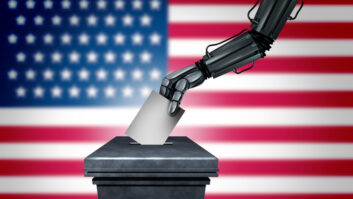Automation, audio streaming, smartspeakers, podcasting, audio search and other technological advancements are of increasing importance to radio, offering as many benefits as they do challenges for modern broadcasters.
As belts tighten and consolidation forces radio stations to seek out new efficiencies and revenue streams, artificial intelligence can be used as a tool for sales and digital teams and programmers.
SMARTSPEAKERS, ASSISTANTS, STREAMING, APPS & MORE
Thanks to advances in machine learning and artificial intelligence, many consumers are more likely to ask their smartphone a question than go to customer service. Fast food restaurants, airports and department stores have all adopted kiosks that can help consumers independently perform tasks that previously required employee assistance.
These AI applications have made human interaction less common, but Jacobs Media President Fred Jacobs points out that people still crave contact that feels human rather than robotic. (Hence the humanoid names and natural-ish voices adopted by Amazon, Apple, Google and other companies’ virtual assistants.)
On his blog, Jacobs writes, “It’s almost ironic then that at a time when technologists are trying to make their robots and gadgets more human, radio often tries to make its humans more robotic. Voicetracking, syndicated shows, liner cards and other tactics designed to be ratings-friendly may be precisely what listeners aren’t looking for when they turn on the radio.”
But improving the user experience is exactly what some companies say they’re trying to do.
iHeartMedia, for example, says it’s using AI to improve its iHeartRadio app and “to create an unmatched digital listening experience for our users,” Chief Product Officer Chris Williams told Radio World in August. Using Super Hi-Fi, he says the company is able to offer customized song transitions and adjust volume discrepancies just like a live DJ would — but at the scalable rate necessary for streaming.
According to Williams, “There are two parts of programming that affect the user experience and have to be considered: curation and presentation. The curation, or song selection, is still based on our custom algorithm, which is influenced by the curation expertise of our world-class radio programmers. The presentation, or how the songs are stitched together, is what’s being enhanced using the Super Hi-Fi AI.”
IT’S NOT ALL BAD NEWS
Even as many DJs fret about automation, syndication and voicetracking putting them out of work, AI saved the job of at least one veteran broadcaster.
In 2016, Cox Media Group national politics reporter James Dupree lost his voice due to tongue protrusion dystonia, but Scottish tech company CereProc has helped get him back on the air, according to a BBC News story written by Mary-Ann Russon.
According to Russon’s article, CereProc started developing neural networks in 2006, and this year has trained one to recreate Dupree’s voice using artificial intelligence that learned from 30 years’ worth of recorded broadcast audio.
CereProc Chief Technical Officer and co-founder Chris Pidcock told the BBC, “AI techniques work quite well on small constrained problems, and learning to model speech is something deep neural nets can do really well.”
Beginning in late June, Dupree uses free text-to-speech software Balabolka to turn his radio scripts into an audio recording that replicates his voice and can be used on air.
CAN AI MAKE MONEY FOR RADIO STATIONS?
On the advertising side, artificial intelligence certainly offers opportunity for broadcasters.
Veritone Media Senior Vice President Drew Hilles says AI is ideal for tasks like monitoring media, transcription and ad verification, as well as jobs like generating reference clips.
“New realities for traditional media may initially cause concern, but revenue generated from radio advertising is not dying. Broadcasters can preserve and enhance their value proposition for advertisers by employing cognitive engine technology. With the use of AI, the once-linear data of audio and video commercials can be efficiently tracked and analyzed, including native content. As a result, broadcasters can not only prove the brand mentions, but also track the value they deliver to their advertisers,” Hilles explained.
Additional opportunities for monetization may be found in the world of smartspeakers (think ads that direct listeners to take action — and then consumers can immediately and seamlessly do so via voice command!).
This list of artificial intelligence applications for radio is far from exhaustive; most of AI’s potential has yet to be discovered, let alone exploited.







